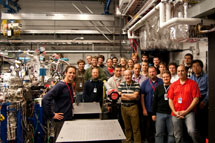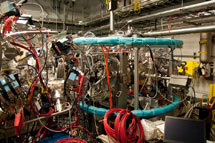
Handy Links
SLAC News Center
SLAC Today
- Subscribe
- Archives: Feb 2006-May 20, 2011
- Archives: May 23, 2011 and later
- Submit Feedback or Story Ideas
- About SLAC Today
SLAC News
Lab News
- Interactions
- Lightsources.org
- ILC NewsLine
- Int'l Science Grid This Week
- Fermilab Today
- Berkeley Lab News
- @brookhaven TODAY
- DOE Pulse
- CERN Courier
- DESY inForm
- US / LHC
SLAC Links
- Emergency
- Safety
- Policy Repository
- Site Entry Form

- Site Maps
- M & O Review
- Computing Status & Calendar
- SLAC Colloquium
- SLACspeak
- SLACspace
- SLAC Logo
- Café Menu
- Flea Market
- Web E-mail
- Marguerite Shuttle
- Discount Commuter Passes
-
Award Reporting Form
- SPIRES
- SciDoc
- Activity Groups
- Library
Stanford
Around the Bay
CAMP-ing at LCLS
Instead of sleeping bags and s'mores fixings, roughly 20 scientists and technicians—part of a large collaboration from the Max Planck Society Advanced Study Group and other institutions—packed 40 containers weighing roughly 10 tons for CAMP. There are no fires, no roasting marshmallows and no tents. Instead, this CAMP is a brand new instrument for a series of three experiments that began November 24 at the Linac Coherent Light Source.
"We needed a four-letter name like LCLS, but thought it should be more fun," joked ASG physicist Daniel Rolles, a coordinator for the project. The CAMP acronym is a combination of key information about the instrument. C is short for CFEL, or the Centre for Free-Electron Laser Science, a new institute located at the physics laboratory DESY in Hamburg, Germany. The CAMP apparatus was designed and built by the Max Planck Society Advanced Study Group, or ASG, which provides the A for the acronym. And the MP? That's for "multi-purpose."
The brand new, one-of-a-kind instrument contains large-scale charge-coupled device, or CCD, imaging tools. The technology was originally designed for astro- and high-energy physics research, but was specially adapted for free electron lasers like the LCLS. The imaging tools can use the LCLS's brilliant X-rays to snap pictures of a large range of materials from nano-particles to biological samples. CAMP also boasts a set of spectrometers complimentary to those in the LCLS Atomic, Molecular & Optical Science instrument endstation where it is installed. These technologies will enable the researchers to measure photons, electrons and ions simultaneously, thus studying in utmost detail a variety of biological molecules, samples from the nanoworld—such as clusters, aligned and oriented molecules and liquids in jets—and fixed-target samples such as solids, surfaces or magnetic materials exposed to the LCLS light flashes.
The CAMP instrument was originally built in Germany, flown to California, then reassembled at SLAC over five weeks this fall. It is currently replacing the back half of the AMO science instrument, which was rolled out of Hutch 1 in the Near Experimental Hall in mid-November. Two days later, the reassembled CAMP instrument was inserted and ready to go. "It's like putting in a whole new AMO," said AMO instrument scientist Christoph Bostedt, who helped connect CAMP to the remaining portion of the AMO science instrument.
Just as getting the AMO science instrument ready for use took a large SLAC effort, the CAMP experiment has needed help from a number of SLAC groups including the Photon Controls, Mechanical Fabrication and Conventional Facilities Departments. "A lot of people have been involved in getting this together," Bostedt said. "There is a footprint across the lab and people are very motivated. We appreciate the work from everyone."
With help from SLAC AMO scientists Bostedt and John Bozek, the CAMP instrument will collect data through the end of the current user run, December 17. Over the course of three weeks, three separate experiments will be performed by up to 100 scientists in collaboration with the ASG.
Following the CAMP experiment, LCLS will enter a scheduled shut-down phase. When users return to CAMP in May, the instrument will be equipped with an alignment laser to record movies of aligned molecules, to serve seven experiments that will be performed during the next user run. After these experiments are completed, the two halves of the AMO science instrument will be put back together in Hutch 1. Meanwhile, a flurry of activity will begin in Hutches 2 and 3 as the next two LCLS instruments—soft X-Ray Materials Science and X-Ray Pump Probe—begin commissioning phases.
More than 40 people from the German collaboration helped bring this project to life. Among the leading CAMP scientists Sascha Epp, Robert Hartmann and Artem Rudenko, Daniel Rolles takes a coordinating role. Joachim Ulrich, Director at the Max Planck Institute for Nuclear Physics, leads the project with Lothar Strüder, head of the Max Planck Semiconductor Laboratory in Munich, and Ilme Schlichting, director at the Max Planck Institute for Medical Research.
—Lauren Knoche
SLAC Today, December 7, 2009

